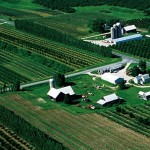
Eating fresher, healthier food would not only be good for our bodies—it would improve the health of our farmland, environment and rural communities.
The Healthy Farmland Diet, a new report from Union of Concerned Scientists (UCS), uses economic modeling techniques to estimate the effects of changing food consumption on agricultural land use.

The report looked at what would happen if Americans ate fruits and vegetables at USDA-recommended levels. The modeling techniques predicted consumption of fruits and vegetables would increase by 173 percent over current levels and U.S. farmers would grow 88 percent more of these foods.
If meat and dairy consumption fell to levels recommended by the Harvard University School of Public Health, the study found farmers would grow less corn and other grain commodity crops used as livestock feed—8 million acres less. Reduced demand for meat would lower agriculture’s contribution to global warming as well.
Growing more fruits and vegetables and less of the commodity crops that currently dominate U.S. agriculture would produce healthier soil, air and water, as well as provide economic benefits in the form of job growth and increased access to healthy foods for farm communities, the study predicted.
Only about 2 percent of U.S. cropland is now used to grow fruits and vegetables, while 59 percent is devoted to commodity crops, such as corn and soybeans, which are used primarily to produce three things: meat, processed foods such as high fructose corn syrup and biofuels such as ethanol.
These crops are grown using monoculture practices that rely on heavy application of fertilizers and pesticides to compensate for their soil-depleting and pest-attracting effects. Monoculture is also less beneficial for local economies than more diverse farm landscapes.
The study also notes that increasing production of healthy foods will have ripple effects in local economies, creating jobs and spurring regional economic development.
Smart, forward-looking farm policies can help attain the goal of increasing production and consumption of healthy foods, UCS said. The group recommends Congress and the USDA should:
Fund and implement programs that help farmers grow more fruits and vegetables, such as removing planting restrictions, developing effective crop insurance programs and investing in research to develop better fruit and vegetable varieties.
Fund and implement policies to improve consumer access to fruits and vegetables, such as bolstering programs to help build market infrastructure and removing obstacles to the use of nutrition-assistance benefits at farmers’ markets.
Curb subsidies that promote production of ingredients for unhealthy processed foods—instead making modest increases in funding for programs, like those above, that help farmers grow the foods Americans need.
Visit EcoWatch’s SUSTAINABLE AGRICULTURE page for more related news on this topic.

[source: http://ecowatch.com/2013/10/31/eating-healthy-improves-farming-environment/]

Leave a Reply
You must be logged in to post a comment.